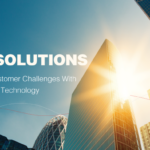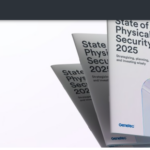Eight Things IT Leaders Should Demand from Physical Security Vendors

As cyber and physical security converge, organizations must select physical security vendors that align with their information technology (IT) infrastructure to safeguard people, data, and assets.
For IT professionals responsible for protecting both digital and physical assets, making the right choice is critical. This checklist outlines what to demand from your next vendor, so your security can meet today’s threats and adapt to tomorrow’s.
Rather than a one-size-fits-all model, the right vendor should help you design a solution that fits your operational needs today and can scale as those needs evolve.
- Align security with business and IT strategy
A modern physical security solution should do more than monitor premises. It should be a strategic fit that enhances the broader organizational goals. Look for unified platforms that integrate video surveillance, access control, automatic license plate recognition (ALPR), communications, forensics, and analytics.
Solutions that offer centralized management and real-time monitoring foster collaboration across security teams, compliance officers, and IT departments. This alignment informs decision-making and drives operational efficiency. Physical security systems also generate a rich stream of operational data, from facility usage trends to incident patterns, that can help improve safety protocols, optimize resources, and support cross-functional insights.
- Ensure technical compatibility
A top-tier solution should complement your existing IT ecosystem, not complicate it. Favor open architectures that integrate seamlessly with core systems, such as Active Directory, cloud platforms, and identity management tools.
Avoid vendor lock-in. Solutions should work with both existing and new deployments. Look for an open API framework that enables custom integrations with third-party tools, giving your team the flexibility to tailor the system to your needs.
- Prioritize cybersecurity and compliance
Security is non-negotiable. Your vendor should support end-to-end encryption and secure data transfer protocols to safeguard sensitive information. Compliance with global standards and regional laws such as GDPR, NIS2, ISO 27001, CCPA/CPRA, and the EU AI Act is essential.
Expect granular user controls, including role-based permissions and multi-factor authentication, as well as comprehensive audit trails to ensure accountability. Vendors should demonstrate cybersecurity maturity through SOC 2 Type II audits and certifications, as well as adherence to ISO/IEC 27017 and ISO/IEC 27001. Look for transparency in their security posture and vulnerability management practices.
- Demand reliability and performance
Your physical security systems must be reliable around the clock. Insist on solutions with high-availability configurations and clearly defined service level agreements (SLAs). Automated failover and disaster recovery capabilities should be built in.
Scalability matters, too. The system should handle growing data volumes and the deployment of new systems and facilities without sacrificing performance.
- Evaluate cost and ROI
Understanding the total cost of ownership (TCO) is essential for long-term planning. Transparent pricing structures should encompass licensing, implementation, and maintenance costs, avoiding hidden fees. Look for solutions that deliver measurable ROI, whether through operational efficiencies, intelligent analytics, or risk mitigation. A flexible, choice-driven approach can offer significant advantages by giving organizations the flexibility to adopt cloud services at their own pace while continuing to use existing on-prem infrastructure. This model offers both technical and financial flexibility, allowing for tailored deployments that align with your specific environment and budget. Rather than a one-size-fits-all model, the right vendor should help you design a solution that fits your operational needs today and can scale as those needs evolve. Flexible licensing models (subscription or perpetual) can help align expenditures with financial planning.
- Assess vendor reputation and support
Vendor stability and reputation matter. Choose a partner with a proven track record and a strong presence in the global physical security market. Examine case studies across various industries to gauge the vendor’s ability to meet diverse security requirements.
Comprehensive support and maintenance offerings are equally important. Look for 24/7 technical assistance, dedicated customer portals, technology partnerships, vendor cybersecurity track record, and a demonstrated commitment to continuous improvement through regular software updates.
- Focus on implementation and user adoption
Deployment should be collaborative and minimally disruptive. The best vendors will work with you to develop a detailed implementation plan and timeline. Prioritize vendors that offer structured change management support, such as phased deployments, hands-on training, stakeholder engagement, and user feedback loops. Empower your teams with robust documentation and training resources to drive adoption and long-term success.
- Conduct risk assessment and pilot testing
A proactive approach to risk is essential. Your vendor should provide clear protocols for vulnerability management and incident response. Pilot programs are invaluable. Insist on the ability to test the solution in your environment before a full deployment. This allows you to validate performance, compatibility, and usability under real-world conditions.
Final thoughts
Selecting a physical security technology vendor is a strategic decision with long-term impact. For IT leaders, the goal is to choose a partner whose solutions integrate seamlessly with your ecosystem, support regulatory compliance, and scale with your organization’s evolving needs.




















